For over 100 years, Wheeler has evolved with changes in ownership and various products and services, but the direction
has been clear: Stay “Committed to Performance.”
Wheeler Biography
In 1892, William Walter Wheeler, a bridge plank salesman for a New England company, was assigned to the Midwest where, noting ample opportunity to build a good future, he formed the Wheeler Lumber Company in Des Moines, Iowa. By 1914, the company became the Wheeler Lumber Bridge and Supply Company. Percy E. Hoak signed on as a salesman in 1917, and when Wheeler died in 1927, Hoak purchased about 70% of the company stock. Warren M. Wells owned the balance.
In 1931, Carl Jensen, who had worked for Standard Bridge Company of Omaha, Nebraska until the Depression, met up with Percy Hoak. “Times were tough and jobs were really scarce,” Jensen remembers. “However, I was able to sell him on the idea that there might be some plank and piling business in South Dakota.” Hoak sent Jensen to South Dakota.
Jensen’s total pay was an expense account of forty dollars per week – but then, hotel rooms were one dollar a night and gasoline fifteen cents a gallon. After three months on the road, Jensen concluded there was not sufficient business in South Dakota to warrant his expense account. He returned to Iowa expecting Hoak would have no further need of him. Hoak surprised him by asking him to work for Wheeler in Minneapolis. “He said with my name I should get along well with those Swedes in Minnesota.”
Go North, Young Man
The Depression was raging. Banks were closing. Roosevelt was elected in the fall of 1932 and implemented various work programs. Wheeler managed to hang on in Minnesota paying the rent and stenographer expenses until 1936 when business began to get better and Joe Timpane was hired as stenographer. “He was a young man who grew with the company. He took very few vacations and turned out to be a terrific salesman,” says Jensen. “He died in 1983 after 45 years with Wheeler and it was his work which began the expansion in this territory.”
In 1939, Wheeler hired their first county salesman. “Minnesota was a virgin state as far as pressure-treated lumber was concerned,” says Jensen. With a good engineer from the Minnesota Highway Department working evenings and weekends, Wheeler developed some stock bridge designs and provided them free of charge to customers.
The plans and specifications required that all timbers be prefabricated – cut to length and holes drilled – prior to treatment. To handle this, Wheeler made a deal with Republic Creosoting Company in St. Louis Park, Minnesota. Wheeler then set up its own framing facilities and built up its first inventory of materials in Minnesota. Jensen and Timpane also assembled some brochures and mailed them to every township supervisor and county commissioner in the state. The response was gratifying and additional salesmen were hired.
“If one thing stands out as most memorable to me it has to be the prefabricated pressure-treated timber bridges,” Jensen reflects. “We began with them in the mid 30’s and they continue to be one of Wheeler’s mainstays with sales throughout the country.”
Wartime
December 1941: “All our local business came to a halt and our efforts were directed to the war,” recalls Jensen.
War facilities were built everywhere and they required lumber. At the time, Wheeler supplied prefabricated timber bridges and they also manufactured a patented wood box culvert called Laminex. Steel was scarce during the war years, so Wheeler was called upon to manufacture many culverts for emergency use, particularly for the Dupont Company. In order to get that wood for the culverts, people from Wheeler attended lumber auctions all over the U.S.
At the same time, Wheeler had an arrangement with the Northern Wood Preservers Company in Port Arthur, Ontario to manufacture culverts in Canada. “We worked together furnishing the materials for the Alaskan Highway. Again, because of the extreme steel shortage, pressure-treated wood was specified for use in both round and square culverts. Northern Wood furnished the round wood culvert and Wheeler, the square Laminex type,” says Jensen.
Though Wheeler did not expand greatly during the war years, the company did install a snow fence making machine at St. Louis Park and also set up a lath mill at Onamia, Minnesota which manufactured lath used in making highway snow fences and portable corn cribs.
In 1943, at the age of 54, Percy Hoak died. “He was such a fine man,” says Jensen, “thoughtful of families and of his employees. He made friends wherever he went from coast to coast, always with an eye for business. He cut a wide swath, and was the finest man I have ever known.”
Warren Wells, part owner of the company, served as president for a short time until Percy’s brother, Leo Hoak, came aboard. Together he and Jensen bought the bulk of Wells’ stock and Wheeler entered its next phase with Leo serving as president and Jensen as vice president.
The War Winds Down, Wheeler Gears Up

Peeled Jack Pine Poles on
Trams in Superior, WI 1946
Wheeler’s big expansion in the Upper Midwest began in 1944. When the Rural Electric Administration (REA) was formed to make electricity available to farms, the need for poles increased. “We wanted a share of that market,” says Jensen, “but the Jack and Norway pine produced in northern Minnesota were not included in the REA’s specifications. “A few trips to Washington and St. Louis, the REA national headquarters, and Wheeler was able to get the specs approved.
Wheeler then worked out an arrangement with the Kopper’s Company who had a treating plant in Superior, Wisconsin where Wheeler built a peeling and framing plant and started wood production.
Jim and Tom Hoak, sons of Percy Hoak, were both back from Naval service in 1945 and Wheeler required supervisory help. Jim was reassigned to the West Coast were he had spent time before volunteering in the Navy and Tom to Superior overseeing that operation. Joe Timpane returned from the service and was sent to Park Rapids, Minnesota to handle production.
Shipments from Superior of the finished product to REA for the first six months were 30,000 poles or about 250 carloads. Within 12 months, that figure doubled!
In 1946, Wheeler was relying 100% on independent wood producers and production was insufficient. So, Wheeler set up its own logging operation at a site north of Isabella, Minnesota, 100 miles from the Superior plant.
Into the Big Woods

Isabella Logging Camp, 1950
Setting up a logging camp is no small task. Horses were needed for skidding, bunk houses for sleeping. Logging required a variety of mechanical equipment and facilities to repair and maintain it. Most of the workers were Finnish, hence a sauna was a must. There was a cook – a cookie – and a bull cook who had sleeping quarters attached to the dining building. “To get good workers you had to have a good dining room,” explains Jensen. “Logging is hard work and appetites are hearty.”
When cookie rang the bell, workers came en masse to the table heaped with food including freshly baked pies. In 20 minutes the loggers were up and gone. There was no talking – just eating. “I remember when Jim Hoak visited the camp one day with Tom and me. As is true with all Hoaks, he liked to talk. When he tried to strike up a dinnertime conversation and got no answer, he was dumbfounded.”
Tom Hoak remembers they used to feed the men for 50 cents a meal. “One time a clerk told me he had a cutter he just couldn’t believe. The logger ate 17 pork chops – for breakfast. “In jest, of course,” says Hoak, “I said, ‘find some way to fire him.'”
“The loggers were hard working, honest men. They came in on the company bus – the only way in and out – late in the fall and stayed until spring. The roads were gravel and a mess in the spring so most of the work was done in winter.” The operation was a success. Wheeler furnished almost all of Northwestern Bell’s poles in Minnesota, North and South Dakota, and Wisconsin.
On to Cass Lake

Logs coming out of treating cylinder
After some experimenting and with an eye to the future, Wheeler decided to treat fence posts. A shop was set up in Cass Lake, Minnesota with one peeling machine and a four-man crew.
With a simple adaptation, Wheeler revolutionized wood post manufacturing and reduced labor costs dramatically. Using steel strapping, they tied the finished product into bundles immediately after peeling. The bundles, about five feet in diameter, fit nicely onto trams which could be moved into six foot diameter cylinders for pressure treatment.
Unlike the previous procedures which required handling posts individually, the posts in bundles were counted only once and properly tagged, put into the yard for seasoning and shipped to Republic Creosoting Company in St. Louis Park. There they were pressure treated, sold, and shipped to retail lumber yard customers – in the same bundles.
By the mid 1950’s, Wheeler built a small treating plant at Cass Lake. It consisted of a 75 foot cylinder with which Wheeler could treat and ship over a million cubic feet per year. In a few years, that cylinder was extended.
At its peak lumbering-days, Wheeler handled a couple of million fence posts a year. “We had the biggest concentration of round products in the world,” recalls Hoak. “We handled 100,000 barn poles and maybe 50,000 telephone poles a year. We made landscape materials out of squares and square guard rail posts. We treated with creosote, penta and chemonite. We furnished at least 90% of the fence posts used on Minnesota and Dakota freeways, 95% of all the guard rails in Minnesota as well as most foundation pilings under concrete and steel bridges.
“The Superior, Cass Lake, and St. Louis Park operations contributed so much to the overall success of the entire Wheeler organization,” reflects Carl Jensen. “This could not have been done without loyalty, cooperation, and hard work from all the employees.”
“It was very exciting to be part of a growing economy which needed our products and innovation. We taught farmers to put poles into the ground as foundations,” Hoak adds. “As a result, many of the auxiliary buildings built in the last 30 years are pole type. It was a wonderful life. It was great to be part of a profitable and growing operation.”
Changing Times

Warehouse in
St. Louis Park, MN, 1950
As the demand for REA poles diminished, Wheeler closed down the plant in Superior and eventually moved all the inventory to Cass Lake. Tom Hoak moved to Minneapolis shortly thereafter. “It was a big relief to close the logging operations down and get rid of the equipment from the camp,” remembers Hoak. In 1950, Wheeler acquired land adjacent to the Republic Creosoting Plant and built a new office building. They moved from the Lumber Exchange Building in Minneapolis to their new offices in 1951.
Tom Hoak explains that as the demand for wood products diminished, Wheeler gradually added metal culverts and metal products. “The poles are so permanent, they need replacing only every 30-40 years. The farm market dried a little as farmers began taking fencing out and planted crops road to road. “Farmers no longer pastured cows but penned them up. As the world changed, we had to go in different directions and become market rather than product oriented. When steel was needed, we furnished steel. When wood was required, we furnished that.”
Wheeler’s foresight meant the company could take full advantage of the post-war high construction boom. “We were the only ones in that type of business. Others tried to break into that field,” remembers Jim Hoak, “but we never had a direct competitor.”
Distribution Yards and Truss Plants
Wheeler’s action was not limited to the north woods. As the need arose, distribution yards, the first of which was developed in 1892, cropped up throughout the Midwest. Although treated wood products were offered from Des Moines, Iowa for many years, eventually untreated lumber, plywood and other building materials were added.
Then, about 1947, in order to capitalize on post-war building, the company began selling a variety of building materials including flooring, siding, and roofing. The materials were sold to about 1,000 retail lumber dealers through distribution yards in Hastings, Minnesota, Norfolk, Nebraska, Des Moines, Iowa and later Rock Island, Illinois. In 1959 the Des Moines yard was moved to a larger facility in West Des Moines. Jim Hoak oversaw the wholesale yards which continued to sell materials to counties in Iowa and Nebraska for use in bridge and highway construction.
The distribution yards experienced growth through the 1970’s. The West Des Moines location was expanded in 1973 when Wheeler began production of wood trusses. After a slow start the truss business took off and in 1980 production was added in Rock Island. A number of new products were added including, paneling, doors and a CCA treating plant.
Meanwhile
At the same time Wheeler was establishing the Superior and Cass Lake operations, St. Louis Park was thriving selling prefabricated timber bridges and Laminex culverts. Cass Lake products were also sold by the bundle to retail lumber yards. Wheeler also acquired bridge material yards in Huron, South Dakota and Bismarck, North Dakota.
In 1947, Wheeler hired Bob Erickson as a design engineer for pressure-treated products. Eventually, Wheeler created a separate engineering firm to design bridges of wood, steel or concrete. Erickson Engineering continues as an important part of Wheeler providing engineering services to many agencies public and private.
Wheeler acquired, in the 1950’s, Northfield Iron and Culvert Company in Northfield, Minnesota and maintained it as a separate corporation. The company manufactured metal culverts and other related steel products. That plant was eventually moved to Shakopee, Minnesota where Wheeler had 15 acres. In the mid-1960’s, Wheeler acquired a wood treating plant in Whitewood, South Dakota. In 1972, Republic Creosoting closed their St. Louis Park treating plant. All Wheeler untreated inventory and manufacturing equipment was moved to Cass Lake and all the treated inventory to Shakopee.
When Leo Hoak retired in the 1960’s, Jim Hoak became president and Tom Hoak secretary/treasurer. Carl Jensen was senior vice president and Herb Schell a vice president. “When Tom and I joined Wheeler after the war,” Jim Hoak reflects, “we rapidly expanded our product base and increased sales volume. We had the gumption to strike out and foresight to imagine what was coming. Fortunately, we made the right decisions often enough.”
The original company was merged with St. Regis Paper Company in 1968. The company did business then as the Wheeler Division of St. Regis Paper Company. During the St. Regis days, other important acquisitions were made. Southern Culvert with operations in Florida was added in the early 1970’s and Panning Lumber with contractor building material yards in Orlando, Florida a few years later. Late in 1984, St. Regis was purchased by Champion International Corporation. In 1985, the Cass Lake plant was closed. Inventory and machinery was moved to Whitewood, South Dakota.
Wheeler Consolidated, Inc.
David Hoak and Kell Williams, members of the families who originally owned Wheeler Lumber and Southern Culvert, along with division managers purchased the Wheeler Division from Champion in 1985. Wheeler Consolidated, Inc. was formed with corporate headquarters located at the West Des Moines location.
Wheeler divested much of what was acquired during the St. Regis days. Panning Lumber, and the metal culvert plants in Minnesota were sold. In 2000, Southern Culvert was sold when Kell Williams chose to retire.
Other Wheeler divisions expanded. In 1996, a truss plant was added just outside Kansas City in Waverly, Kansas.
The landscape supply division, formed in the early 1980’s at the Shakopee location to sell treated landscape timbers, expanded in 1985 to distribute concrete modular block and private label landscape fabric to contractors in the greater Minneapolis area. Later, additional distribution yards were added in St. Paul and Brooklyn Park, Minnesota, providing a full line of landscape products.
To follow the demand for recreation bridges, Wheeler began production of prefabricated steel bridges. A plant was added at the existing facility in Shakopee in 1998. Marketed nationwide along with treated timber bridges, the steel division has grown to become a significant part of Wheeler.
When the Cass Lake location closed, Whitewood became the focus for timber bridge production and timber treating. Timber bridge components are shipped nationwide from the Black Hills. Treated timber fence posts and other farm products are sold to local farm stores throughout Plains and into Rocky Mountain states.
Wheeler Lumber, LLC
After the sale of Southern Culvert the company was reorganized as Wheeler Lumber, LLC.
The Whitewood facilities were upgraded in 2003 with a rebuilt, state-of-the-art treating plant and the conversion to Copper Naphthenate as the primary wood preservative.
The need for larger and updated office space brought an end to the St. Louis Park location in 2002. After many years on Republic Avenue, Erickson Engineering and the Management, Sales and Engineering staff for Highway Products moved to Bloomington, Minnesota.
Market down turns in 2007 forced the closing of the West Des Moines truss plant and distribution yard. The corporate headquarters were moved to Des Moines. The Rock Island plant closed a year later. Wholesale building products are still sold through our Des Moines office and Waverly continues to offer truss and wall panel manufacturing.
September of 2017 saw the Wheeler Bloomington office move to more modern facilities in Eden Prairie, MN.
We are greatly saddened by the passing of David Hoak in July of 2022. David continued the history of leadership by the Hoak family, combining quality management and guidance with heartfelt love for and enjoyment of his family, friends, and community, as well as his employees. He will be very much missed.
With an eye on the future, Wheeler’s mission is “to provide quality building materials and related services which serve both private and public infrastructures.”
A special thanks is given to Duane Bell, retired vice president of Wheeler, for his contribution to this biography.